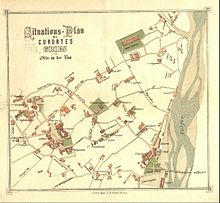Grieser Platz
| Grieser Platz | |
|---|---|
| Place in Bolzano | |
 Historical photo of Grieser Platz from 1927, seen in the direction of Guntschnaberg |
|
| Basic data | |
| place | Bolzano |
| District | Semolina quirein |
| Created | 13th Century |
| Hist. Names | "Village square" |
| Confluent streets | Fagenstrasse, Freiheitsstrasse , Penegalstrasse, Vittorio-Veneto-Strasse |
| Buildings | Muri-Gries Abbey with collegiate church, Gasthof Weißes Kreuz, Altmesnerhof, Altes Gries parish hall, Münzbank |
| use | |
| User groups | Pedestrian traffic , motor traffic , events |
The Grieser Platz ( Italian: Piazza Gries ) is located in the Gries-Quirein district of the South Tyrolean capital Bozen .
The spacious, traffic-important and central place owes its layout to the 13th century and is the natural center of the city quarter, which was not incorporated into Bozen until 1925/26. The old name of the square was Dorfplatz , after the rural community of Gries was elevated to a market place by Emperor Franz Joseph I , the square was called Kaiser-Franz-Josefs-Platz until the Italian annexation of South Tyrol as a result of the First World War . At the time of fascism , the square had the exclusively Italian name Piazza Tiberio , which was only changed in 1945 in favor of the current name. In the first half of the 20th century, an electrified tram connected Grieser Platz with Bozen train station ; it led along the former Meraner Reichsstraße (today's Diazstraße).
Grieser Platz is bordered on three sides by compact blocks of houses and on the north side by the Benedictine abbey of Muri-Gries with the late baroque Augustinus Church. On the mountain side, the old Goldenes Kreuz inn (today's restaurant and music school Gries) and the former Gries town hall designed by Sebastian Altmann (today's community center) form an approximately right-angled corner. On the east side, the street axis laid out by the fascist regime in 1935/36 leads to today's Freiheitsstraße , starting from the old coin bank, in a straight line to the Talfer Bridge and the old town area of Bozen. Until then, the square was connected to the central town of Bozen via the former Vinschgauer Landstrasse or Reichsstrasse (today's Diazstrasse).
The old quarter name of the square area was Hof . Already in the under Duke Sigmund of Austria Tirol adopted district court order of Gries-Bozen by 1487 the place is under the name "of the space-ze Gries before the monastery" as Aufgebotsort mentioned in documents.
Grieser Platz is also currently an important traffic junction, as this is where the junction of the main road to Merano ends, as well as the venue on certain dates. The square is functionally and economically significant, as it is lined with retail shops, restaurants and cafes, a hotel and public facilities.
Individual evidence
- ^ Karl Felix Wolff : Guide through Bozen-Gries. With special consideration of the mountain railways and the Dolomite Road. Bolzano: Self-published by the author 1914, p. 152.
- ↑ Hannes Obermair , Fabrizio Miori, Maurizio Pacchiani (eds.): Lavori in Corso - The Bozner Freiheitsstraße . La Fabbrica del Tempo - The Time Factory, Bozen 2020, ISBN 978-88-943205-2-7 .
- ↑ Joseph Tarneller : The castle, farm and field names in the market town of Gries near Bolzano. (Schlern writings 6). Innsbruck: Universitätsverlag Wagner 1924, p. 40.
- ^ Hannes Obermair: Bozen Süd - Bolzano Nord. Written form and documentary tradition of the city of Bozen up to 1500 . tape 2 . City of Bozen, Bozen 2008, ISBN 978-88-901870-1-8 , p. 191-192, no. 1230 .
Coordinates: 46 ° 30 '10 " N , 11 ° 20' 4.6" E
